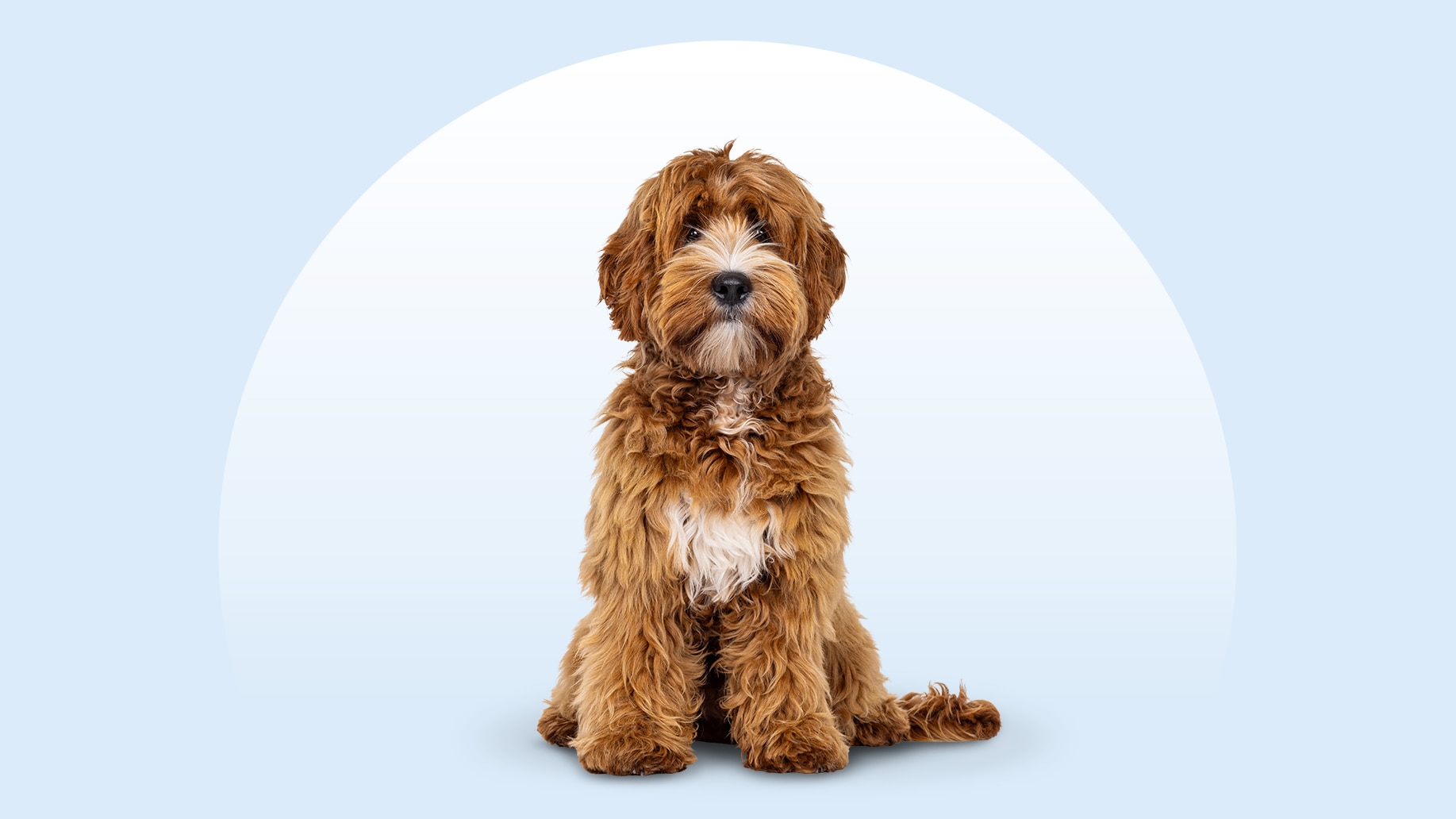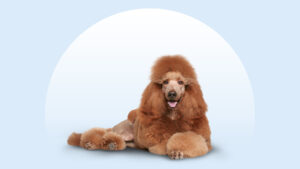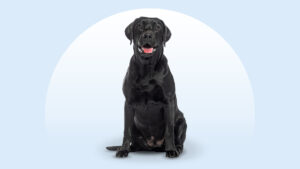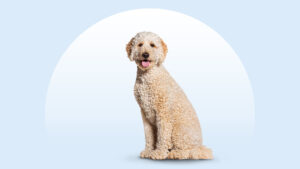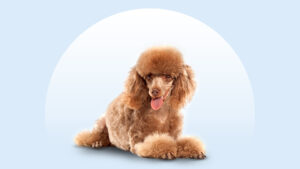Labradoodle
Updated September 16, 2025
Labradoodle
Updated September 16, 2025
Known for their high energy, playful personality, and low-shed coat, Labradoodles make great dogs for active pet parents. These medium-to-large dogs thrive on mental stimulation and an exercise routine, and they’re happiest when getting plenty of love and attention (and treats!) from their family.
Bright, Affectionate, Always Up for Fun
Standard: 50–70 pounds
Miniature: 40–50 pounds
Standard: 20–25 inches
Miniature: 16–20 inches
12–15 years
Apricot, Black, Brown, Cafe au Lait, Cream, Lavender, Yellow
Labradoodles are a cross between two of the smartest, most beloved breeds: the Poodle and the Labrador Retriever. It’s no wonder these dogs are so popular!
If you love to spend your free time taking hikes, going on runs, or exploring the outdoors, you’ll love having a Labradoodle as a companion. Their love of play and exercise will keep you busy thinking up new adventures. Your dog will be the center of attention with their big personality and irresistibly curly coat that’s sure to win over new admirers with every outing.
Here’s another perk of bringing home a Labradoodle puppy: Thanks to their Poodle genes, Labradoodles are commonly considered hypoallergenic dogs. So if you tend to sneeze or itch around pups, they might be your perfect match.
The exact combination of Lab and Poodle will play a role in your dog’s appearance and personality:
- A Labradoodle puppy who has a Labrador parent and a Poodle parent is considered an F1 Labradoodle—an even 50-50 mix.
- An F1b Labradoodle has a Labradoodle parent and a Poodle parent. This makes them more likely to take on Poodle-specific traits, like a curly coat.
- F2 Labradoodles are crosses of two F1 Labradoodle parents. Characteristics are harder to predict in F2 Labradoodle puppies.
Labradoodle Characteristics
Labradoodle Appearance
Labradoodles come in two sizes, depending on whether they share DNA with a Standard Poodle or a Miniature Poodle.
Because they’re a Poodle mix with no set breed standard, there’s no way to know 100% what your Labradoodle puppy will grow to look like. For example, they can be a wide range of colors and have a coat that’s either long and wavy, or tight and curly.
“The biggest predictability of that will be looking at the parents,” says Brian Faulkner, BVMS, associate professor at Nottingham University.
But in general, Labradoodles have bright, friendly eyes; a round button nose; and floppy ears.
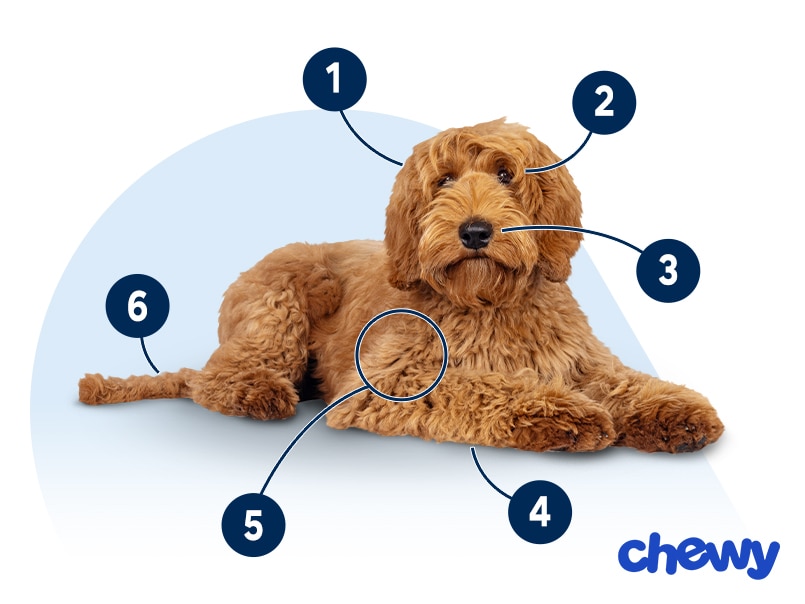
- Ears
Labradoodle ears are set around eye level and hang down beside their head.
- Eyes
The round eyes of a Labradoodle are warm and friendly. Their color often depends on the coat color but is typically shades of brown.
- Nose
Their nose is large and round. Like a Labradoodle’s eyes, their nose color varies by coat, and may be either brown or black.
- Coat Length
Labradoodle coats are long and can be either curly or wavy, depending on the dog.
- Coat Color
Their coats come in a range of colors, including brown, apricot, lavender, cafe au lait, cream, black, and multicolor. Chocolate Labradoodles, yellow Labradoodles, and black Labradoodles are among the most common colors.
- Tail
Most Labradoodles have a long tail that points happily toward the sky.
Labradoodle Temperament
Labradoodles are among the most popular doodle dogs, and it’s easy to see why. Jovial and fun-loving, Labradoodles make great family dogs and outgoing companions.
Though a Labradoodle’s personality varies from pup to pup, they have a reputation for being playful, friendly, and affectionate. Dr. Faulkner says that dogs with more Labrador DNA may be a bit more laid back, while Labradoodles who take after their Poodle side (F1b Labradoodles) are often more exuberant and quirky.
Labradoodles love to be in the company of their family, and do well with other animals and kids. They crave lots of attention, and if they’re bored or understimulated, Labradoodles may complain by barking. This is especially true for those with heavier Poodle traits.
But Poodles and Labrador Retrievers are both people-pleasers, which makes them eager to learn. With patience and positive reinforcement, you can teach your dog to be alone, which can reduce barking and anxiety.
Labrador Retrievers and Poodles are both skilled working dogs originally bred to hunt. So, it makes sense that the Labradoodle—who was also bred for work (more on that later)—is up for almost any activity. Playing fetch at the park? They’re always game. Competing in dog sports like agility trials and dock diving? They’ll be a star.
How to Care for a Labradoodle
As an upbeat social butterfly, a Labradoodle needs lots of attention and playtime from their favorite person. (That’s you!) Don’t overlook grooming as part of your doting care: Depending on the type of coat your Labradoodle pup inherits, they’ll need lots of brushing and regular haircuts.
Grooming
Training
Diet
Exercise
Environment
Labradoodle Health
Both Poodles and Labrador Retrievers are generally healthy breeds, and the same goes for Labradoodles.
“As a vet and owner of two Labradoodles myself, I don’t see too many [health] issues,” Dr. Faulkner says. He notes that skin conditions and orthopedic diseases tend to be the most common when he does see a Labradoodle patient.
The typical Labradoodle lifespan is 12–15 years, and watching for signs of common health issues will help your pup live a long and happy life. Here’s what to look out for.
- Hip dysplasia: Larger dogs (like Standard Labradoodles) are prone to orthopedic issues such as hip dysplasia, a condition where the hip joint doesn’t fit together properly. This causes pain and (if left untreated) arthritis in dogs. Treatment may include pain medication, joint supplements, physical therapy, and (in some cases) surgery.
- Elbow dysplasia: Like hip dysplasia, elbow dysplasia is an orthopedic condition where the elbow joint doesn’t develop as it should, leading to pain and arthritis. This condition can cause swelling, lameness, limping, and decreased range of motion. Surgery is often recommended for dogs with elbow dysplasia.
- Skin conditions: Labradoodles can have thick, curly hair as part of their Poodle DNA. While this trait is an adorable part of the breed, it also makes them more prone to skin conditions such as sebaceous adenitis, an autoimmune disease that causes the skin’s oil glands to inflame. Watch for symptoms such as dryness, hair loss, and excessive licking or scratching.
- Eye issues: Your Labradoodle may be susceptible to eye issues, including the following:
- Glaucoma: A painful condition where pressure builds in the eyes from undrained fluid
- Progressive retinal atrophy: An inherited, painless eye disease that leads to blindness
- Cataracts: A hazy clouding on the lens of the eye that hinders vision
Labradoodle History
Before Labradoodles became designer dogs, they were working dogs.
The first Labradoodle puppies were bred in 1989 by Wally Conron, a breeder who worked with the Royal Guide Dogs Association of Australia. A blind woman in Hawaii had contacted the organization and asked for a service dog who wouldn’t trigger her husband’s allergies.
Conron thought of the Standard Poodle, a breed known for being hypoallergenic. Combined with the friendly and trainable personality of the Labrador Retriever—already a reliable guide dog breed—Conron hoped to create a breed that could serve as excellent guide dogs for people with both vision impairment and allergies.
The first known litter included a Labradoodle puppy named Sultan, who became a successful guide dog for the woman in Hawaii.
But when Conron tried to find work for the remaining Labradoodle puppies, he found that people weren’t interested in trusting a crossbreed as their service dog. Up to this point, crossbreeds were not popular. So in an attempt to make his breed more appealing, Conron gave them a special name.
“He made them sound more unique than simply referring to them as a ‘crossbreed’ by using a combination of names,” Dr. Faulkner says. “And of course, this idea has caught on with many crosses over the last 10–15 years.”
The Labradoodle rebrand was a success, and the breed’s popularity took off. Today, the Labradoodle is one of the most popular designer dog breeds, although they’re not currently recognized by the American Kennel Club (AKC).
Curious about where you can find a Labradoodle to call your own? Look for reputable breeders with healthy, happy, outgoing dogs. Labradoodle price points can range from $1,000–$4,000, and depend on factors such as age and generation.
If you’re looking to cut down on the cost or support dogs in special need of a home, you can look for Labradoodle rescue dogs instead. Check Labradoodle rescue sites such as IDOG Rescue, Inc., for Labradoodle adoption opportunities, or call your local shelter to see if there are any doodles available.
